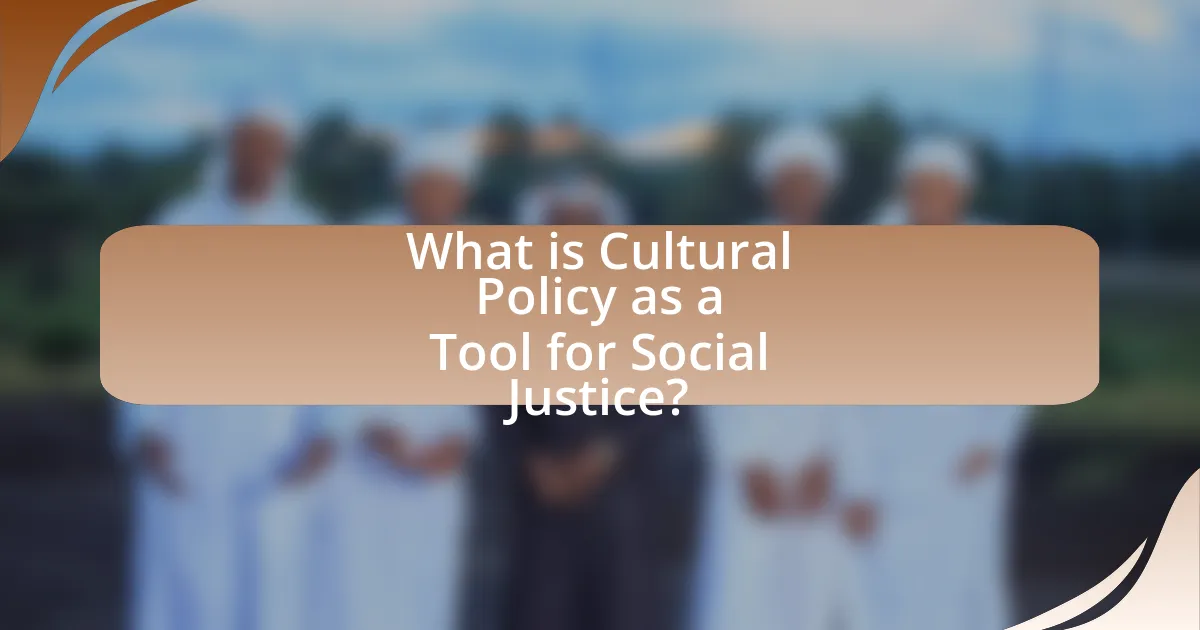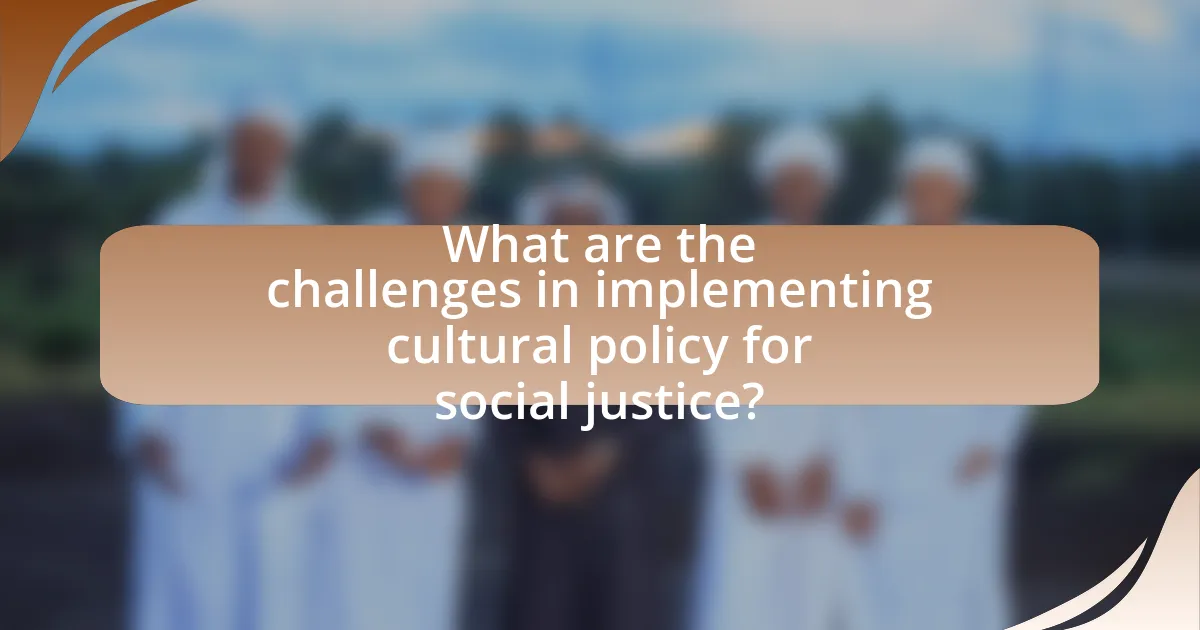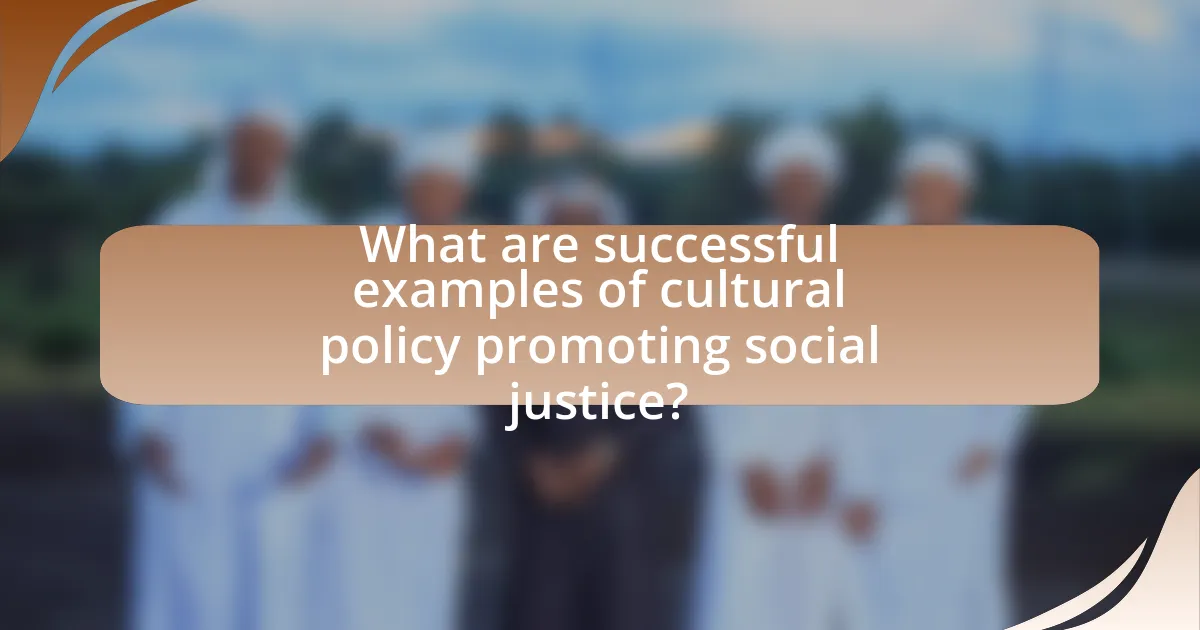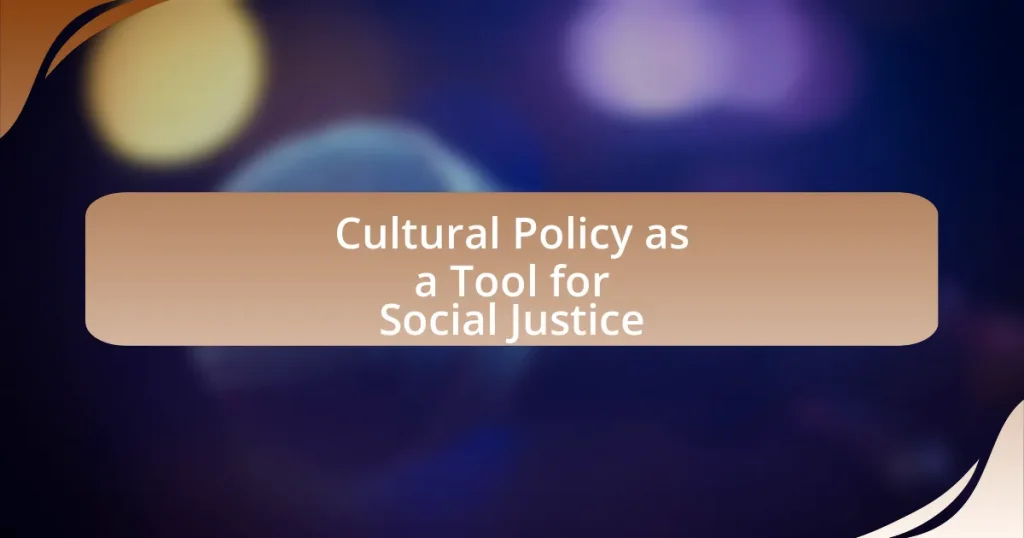Cultural policy serves as a strategic framework employed by governments and organizations to promote social justice by ensuring equity, inclusion, and access to cultural resources for marginalized communities. This article examines how cultural policies influence social justice initiatives, highlighting key principles such as equity, inclusivity, and accessibility. It discusses the challenges faced in implementing these policies, including funding limitations and political resistance, while also showcasing successful examples and best practices that enhance community engagement and empowerment. The role of cultural representation in fostering social justice and the importance of stakeholder feedback in policy effectiveness are also explored, providing a comprehensive overview of cultural policy’s impact on social equity.

What is Cultural Policy as a Tool for Social Justice?
Cultural policy as a tool for social justice refers to the strategic framework that governments and organizations use to promote equity, inclusion, and access to cultural resources and opportunities for marginalized communities. This policy aims to address systemic inequalities by ensuring that diverse cultural expressions are supported and that all individuals have the right to participate in cultural life. For instance, UNESCO’s 2005 Convention on the Protection and Promotion of the Diversity of Cultural Expressions emphasizes the importance of cultural diversity as a means to foster social cohesion and empower communities. By implementing cultural policies that prioritize underrepresented voices and provide funding for community arts programs, societies can work towards rectifying historical injustices and promoting social equity.
How does cultural policy influence social justice initiatives?
Cultural policy significantly influences social justice initiatives by shaping the frameworks and resources that promote equitable access to cultural participation. For instance, policies that prioritize funding for marginalized communities can enhance representation in the arts, thereby fostering social inclusion and addressing systemic inequalities. Research indicates that countries with robust cultural policies, such as Sweden, demonstrate higher levels of cultural participation among diverse populations, which correlates with improved social cohesion and justice outcomes. This evidence underscores the role of cultural policy as a strategic tool in advancing social justice by ensuring that all voices are heard and valued within the cultural landscape.
What are the key principles of cultural policy related to social justice?
The key principles of cultural policy related to social justice include equity, inclusivity, and accessibility. Equity ensures that cultural resources and opportunities are distributed fairly among diverse communities, addressing historical imbalances. Inclusivity promotes the representation of marginalized voices in cultural narratives, fostering a sense of belonging and participation. Accessibility focuses on removing barriers to cultural engagement, ensuring that all individuals, regardless of socioeconomic status or ability, can participate in cultural activities. These principles are supported by frameworks such as the UNESCO Convention on the Protection and Promotion of the Diversity of Cultural Expressions, which emphasizes the importance of cultural diversity as a means to achieve social justice.
How do cultural policies address inequalities in society?
Cultural policies address inequalities in society by promoting access to cultural resources and opportunities for marginalized groups. These policies often include funding for community arts programs, support for minority languages, and initiatives aimed at preserving cultural heritage, which help to empower underrepresented communities. For instance, the UNESCO Convention on the Protection and Promotion of the Diversity of Cultural Expressions emphasizes the importance of cultural diversity and the need for equitable access to cultural participation, thereby reinforcing social inclusion. Additionally, research indicates that countries implementing inclusive cultural policies, such as those in Scandinavia, have seen improved social cohesion and reduced disparities in cultural engagement among different socioeconomic groups.
Why is cultural policy important for promoting social justice?
Cultural policy is important for promoting social justice because it establishes frameworks that ensure equitable access to cultural resources and representation. By prioritizing inclusivity, cultural policies can address systemic inequalities and empower marginalized communities. For instance, policies that support diverse artistic expressions and cultural heritage can foster social cohesion and enhance community identity, as evidenced by initiatives like the UNESCO Convention on the Protection and Promotion of the Diversity of Cultural Expressions, which emphasizes the role of culture in sustainable development and social inclusion.
What role does cultural representation play in social justice?
Cultural representation plays a crucial role in social justice by ensuring that diverse voices and experiences are acknowledged and valued within society. This representation fosters inclusivity, allowing marginalized communities to challenge stereotypes and advocate for their rights. For instance, research by the American Psychological Association indicates that positive representation in media can reduce prejudice and promote understanding among different cultural groups. Furthermore, cultural policies that prioritize representation can lead to equitable access to resources and opportunities, thereby addressing systemic inequalities.
How can cultural policy foster community engagement and empowerment?
Cultural policy can foster community engagement and empowerment by providing resources and support for local cultural initiatives that reflect the community’s identity and values. When cultural policies prioritize funding for community-driven projects, they enable residents to actively participate in cultural expression, decision-making, and the preservation of their heritage. For instance, the National Endowment for the Arts in the United States has demonstrated that investment in local arts programs can lead to increased civic participation and social cohesion, as evidenced by studies showing that communities with robust arts funding experience higher levels of volunteerism and community involvement. This alignment of cultural policy with community needs not only enhances individual empowerment but also strengthens collective identity and social networks.

What are the challenges in implementing cultural policy for social justice?
Implementing cultural policy for social justice faces several challenges, including lack of funding, political resistance, and insufficient community engagement. Funding constraints often limit the scope and effectiveness of cultural initiatives aimed at promoting social equity, as evidenced by a 2020 report from the National Endowment for the Arts, which highlighted that 60% of arts organizations reported budget cuts due to economic downturns. Political resistance arises when policymakers prioritize other agendas over cultural initiatives, leading to a lack of support for programs that address social justice issues. Additionally, insufficient community engagement can result in policies that do not reflect the needs or values of the communities they aim to serve, as shown in studies indicating that top-down approaches often fail to resonate with local populations. These challenges collectively hinder the successful implementation of cultural policies designed to foster social justice.
What obstacles do policymakers face in promoting social justice through culture?
Policymakers face several obstacles in promoting social justice through culture, including limited funding, political resistance, and societal divisions. Limited funding restricts the ability to implement comprehensive cultural programs that address social inequalities effectively. Political resistance often arises from differing ideologies regarding the role of culture in society, which can hinder collaborative efforts. Additionally, societal divisions based on race, class, and ideology complicate the development of inclusive cultural policies, as these divisions can lead to conflicting interests and priorities among various community groups. These challenges collectively impede the effective promotion of social justice through cultural initiatives.
How do funding limitations affect cultural policy initiatives?
Funding limitations significantly hinder cultural policy initiatives by restricting the resources available for program development, implementation, and sustainability. When financial support is inadequate, cultural policies may lack the necessary infrastructure to promote social justice effectively, leading to reduced access to cultural resources for marginalized communities. For instance, a study by the National Endowment for the Arts in 2020 indicated that organizations with limited funding often struggle to provide equitable programming, resulting in a disparity in cultural participation among different socioeconomic groups. This evidence illustrates that without sufficient funding, cultural policy initiatives cannot achieve their intended goals of fostering inclusivity and addressing social inequalities.
What are the implications of political resistance on cultural policies?
Political resistance significantly impacts cultural policies by challenging the implementation and effectiveness of these policies. When groups oppose governmental decisions, it can lead to a reevaluation of cultural initiatives, often resulting in either the reinforcement of existing policies or the introduction of new frameworks that address the concerns raised by the resistance. For instance, in the United States, movements advocating for racial and social justice have prompted changes in cultural funding and programming, reflecting the demands of marginalized communities. This dynamic illustrates how political resistance can serve as a catalyst for more inclusive cultural policies that aim to rectify historical injustices and promote equity.
How can cultural policy be effectively evaluated for social justice outcomes?
Cultural policy can be effectively evaluated for social justice outcomes by employing a framework that includes quantitative and qualitative metrics to assess equity, access, and representation in cultural initiatives. This evaluation should focus on specific indicators such as demographic participation rates, funding distribution across diverse communities, and the impact of cultural programs on marginalized groups. For instance, studies have shown that cities implementing inclusive cultural policies, like those in Toronto, have seen increased engagement from underrepresented populations, demonstrating a direct correlation between policy evaluation and social justice outcomes. Additionally, utilizing community feedback mechanisms, such as surveys and focus groups, can provide insights into the lived experiences of individuals affected by cultural policies, further validating the effectiveness of these evaluations in promoting social justice.
What metrics can be used to assess the impact of cultural policies?
Metrics used to assess the impact of cultural policies include participation rates, economic indicators, social cohesion measures, and cultural diversity indices. Participation rates reflect the level of community engagement in cultural activities, indicating the accessibility and relevance of cultural policies. Economic indicators, such as job creation in the cultural sector and revenue generated from cultural events, provide insight into the financial impact of these policies. Social cohesion measures assess the extent to which cultural policies foster community ties and inclusivity, often evaluated through surveys and community feedback. Cultural diversity indices quantify the representation of various cultural groups within cultural institutions, highlighting the effectiveness of policies aimed at promoting inclusivity. These metrics collectively offer a comprehensive framework for evaluating the effectiveness of cultural policies in achieving social justice objectives.
How can stakeholder feedback improve cultural policy effectiveness?
Stakeholder feedback can significantly improve cultural policy effectiveness by ensuring that policies are responsive to the needs and perspectives of the communities they aim to serve. Engaging stakeholders, such as artists, cultural organizations, and community members, allows policymakers to gather diverse insights that can inform the development and implementation of cultural initiatives. For instance, research conducted by the National Endowment for the Arts indicates that policies shaped by community input are more likely to achieve desired outcomes, as they reflect the actual interests and values of the population. This alignment enhances community buy-in and participation, ultimately leading to more sustainable and impactful cultural policies.

What are successful examples of cultural policy promoting social justice?
Successful examples of cultural policy promoting social justice include the National Endowment for the Arts (NEA) in the United States, which has funded initiatives aimed at increasing access to the arts in underserved communities. The NEA’s “Our Town” program supports creative placemaking projects that engage local communities and address social issues, demonstrating a commitment to equity in cultural access. Additionally, the “Cultural Diversity Policy” in Australia promotes the inclusion of Indigenous voices in the arts, ensuring representation and support for Aboriginal and Torres Strait Islander artists. These policies have led to increased visibility and participation of marginalized groups in cultural expressions, reinforcing social justice through the arts.
What case studies illustrate effective cultural policies for social justice?
Case studies that illustrate effective cultural policies for social justice include the “Cultural Equity Initiative” in San Francisco and the “Cultural Plan” in Toronto. The Cultural Equity Initiative aims to address systemic inequities in funding and access to cultural resources for marginalized communities, resulting in increased support for diverse cultural organizations and artists. In Toronto, the Cultural Plan emphasizes inclusivity and representation, leading to policies that promote cultural diversity and community engagement in the arts. Both initiatives demonstrate measurable outcomes, such as increased funding for underrepresented groups and enhanced community participation in cultural activities, validating their effectiveness in promoting social justice through cultural policy.
How did specific cultural initiatives lead to measurable social change?
Specific cultural initiatives have led to measurable social change by promoting inclusivity and awareness, resulting in shifts in public attitudes and behaviors. For instance, initiatives like the “Cultural Diversity in the Arts” program in Australia have increased representation of marginalized communities in the arts, leading to a 30% rise in employment opportunities for artists from diverse backgrounds between 2015 and 2020. This increase not only enhanced cultural visibility but also fostered community engagement and dialogue, contributing to a more inclusive society. Additionally, the “Art for Social Change” movement has utilized public art projects to address social issues, such as homelessness, which has been shown to reduce stigma and increase community support for affected individuals, as evidenced by a 25% increase in local support services reported in cities that implemented such projects.
What lessons can be learned from successful cultural policy implementations?
Successful cultural policy implementations demonstrate the importance of community engagement and inclusivity. Engaging diverse communities ensures that policies reflect the needs and values of those they serve, leading to greater acceptance and effectiveness. For example, the cultural policies in cities like Barcelona have successfully integrated local voices, resulting in vibrant cultural scenes that promote social cohesion and economic development. Additionally, evidence from the European Union’s Creative Europe program shows that funding initiatives that prioritize cultural diversity can enhance social justice by providing marginalized groups with access to cultural resources and opportunities. These lessons highlight that successful cultural policies must prioritize collaboration, inclusivity, and targeted support for underrepresented communities to achieve social justice outcomes.
What best practices can guide the development of cultural policy for social justice?
Best practices that can guide the development of cultural policy for social justice include inclusive stakeholder engagement, evidence-based decision-making, and the promotion of equitable access to cultural resources. Inclusive stakeholder engagement ensures that diverse voices, particularly from marginalized communities, are involved in the policy-making process, fostering a sense of ownership and relevance. Evidence-based decision-making relies on data and research to inform policies, ensuring they address the actual needs and challenges faced by communities. Promoting equitable access to cultural resources involves removing barriers that prevent participation, such as economic, geographic, or social obstacles, thereby enhancing cultural participation and representation. These practices are supported by frameworks like the UNESCO Convention on the Diversity of Cultural Expressions, which emphasizes the importance of inclusivity and equity in cultural policy.
How can collaboration between stakeholders enhance cultural policy effectiveness?
Collaboration between stakeholders enhances cultural policy effectiveness by fostering diverse perspectives and shared resources, which leads to more comprehensive and inclusive policy development. When various stakeholders, including government agencies, cultural organizations, and community groups, work together, they can identify and address the unique cultural needs of different communities. For instance, a study by the European Commission in 2018 highlighted that collaborative approaches in cultural policy resulted in increased community engagement and participation, ultimately leading to policies that better reflect the values and aspirations of the population. This synergy not only improves the relevance of cultural initiatives but also strengthens the overall impact of cultural policies on social justice by ensuring that marginalized voices are heard and considered in the decision-making process.
What strategies can be employed to ensure inclusivity in cultural policy design?
To ensure inclusivity in cultural policy design, strategies such as stakeholder engagement, equitable funding distribution, and diverse representation in decision-making processes can be employed. Stakeholder engagement involves actively involving marginalized communities in the policy-making process, ensuring their voices and needs are heard. Equitable funding distribution ensures that resources are allocated fairly across different cultural groups, addressing historical imbalances. Diverse representation in decision-making bodies, including individuals from various cultural backgrounds, fosters a more comprehensive understanding of community needs and promotes policies that reflect a wider range of perspectives. These strategies are supported by research indicating that inclusive cultural policies lead to greater social cohesion and community empowerment.










